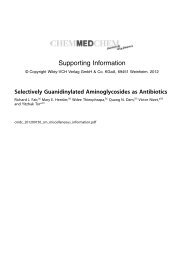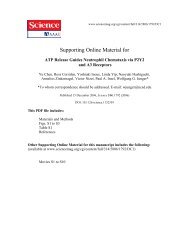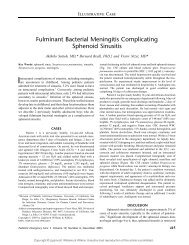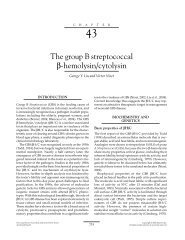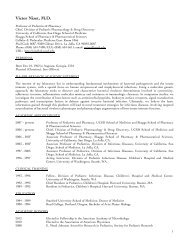BACTERIAL SEPSIS AND MENINGITIS - Nizet Laboratory at UCSD
BACTERIAL SEPSIS AND MENINGITIS - Nizet Laboratory at UCSD
BACTERIAL SEPSIS AND MENINGITIS - Nizet Laboratory at UCSD
Create successful ePaper yourself
Turn your PDF publications into a flip-book with our unique Google optimized e-Paper software.
intravenous c<strong>at</strong>heters produce a mucoid substance (i.e.,<br />
slime or glycocalyx) th<strong>at</strong> stimul<strong>at</strong>es adherence of microcolonies<br />
to various surfaces in the environment and on<br />
epithelial surfaces, ultim<strong>at</strong>ely leading to establishment of<br />
a biofilm [96,97]. In addition to this adhesin function,<br />
the slime may protect staphylococci against antibiotics<br />
and host defense mechanisms such as macrophage phagocytosis<br />
[98]. Parenteral nutrition with a lipid emulsion<br />
administered through a venous c<strong>at</strong>heter with organisms<br />
adherent to the polymer provides nutrients for growth<br />
of the bacteria, leading to invasion of the bloodstream<br />
when the organisms reach an inoculum of sufficient size<br />
[99]. Disease in newborn infants caused by S. aureus and<br />
CoNS is discussed in detail in Chapter 17.<br />
LISTERIA MONOCYTOGENES<br />
The potential of L. monocytogenes to contamin<strong>at</strong>e food<br />
products and the resultant danger to immunocompromised<br />
p<strong>at</strong>ients and pregnant women was reconfirmed in<br />
a 2002 outbreak involving 46 p<strong>at</strong>ients in eight st<strong>at</strong>es. This<br />
outbreak resulted in seven de<strong>at</strong>hs of adults and miscarriages<br />
or stillbirths in three pregnant women [100].<br />
Listeria can be found in unprocessed animal products,<br />
including milk, me<strong>at</strong>, poultry, cheese, ice cream, and<br />
processed me<strong>at</strong>s, and on fresh fruits and vegetables. The<br />
organism possesses several virulence factors th<strong>at</strong> allow it<br />
to infect the fetal placental unit, survive and replic<strong>at</strong>e<br />
within human cells, and achieve cell-to-cell spread [101].<br />
Although most people exposed to L. monocytogenes do<br />
not develop illness, pregnant women can suffer fetal loss,<br />
and neon<strong>at</strong>es can develop early-onset or l<strong>at</strong>e-onset sepsis<br />
and meningitis. Neon<strong>at</strong>al disease resulting from Listeria<br />
is discussed in detail in Chapter 14.<br />
ESCHERICHIA COLI<br />
E. coli is second only to GBS as the most common cause<br />
of early-onset and l<strong>at</strong>e-onset neon<strong>at</strong>al sepsis and meningitis<br />
[9,102–104]. Coliform organisms are prevalent in<br />
the m<strong>at</strong>ernal birth canal, and most infants are colonized<br />
in the lower gastrointestinal or respir<strong>at</strong>ory tracts during<br />
or just before delivery. The antigenic structure of E. coli<br />
is complex; members of this species account for more<br />
than 145 different som<strong>at</strong>ic (O) antigens, approxim<strong>at</strong>ely<br />
50 flagellar (H) antigens, and 80 different capsular (K)<br />
antigens. Although there is a wide genetic diversity of<br />
human commensal isol<strong>at</strong>es of E. coli, strains causing neon<strong>at</strong>al<br />
p<strong>at</strong>hology are derived from a limited number of<br />
clones [105]. One of these, the O18:K1:H7 clone, is<br />
distributed globally, whereas others such as O83:K1 and<br />
O45:K1 are restricted to a smaller subset of countries<br />
[106]. The presence of a 134-kDa plasmid encoding iron<br />
aquisition systems and other put<strong>at</strong>ive virulence genes is<br />
characteristic of several of these clones, and loss of the<br />
plasmid reduces the virulence more than 100-fold in a<br />
neon<strong>at</strong>al r<strong>at</strong> model of E. coli meningitis [107].<br />
The K1 capsular antigen present in certain strains of<br />
E. coli is uniquely associ<strong>at</strong>ed with neon<strong>at</strong>al meningitis<br />
[108–110]. K1 antigen is polysialic acid th<strong>at</strong> is immunochemically<br />
identical to the capsular antigen of group B<br />
N. meningitidis. McCracken and coworkers [109] found<br />
CHAPTER 6 Bacterial Sepsis and Meningitis<br />
233<br />
K1 strains in the blood or CSF of 65 of 77 neon<strong>at</strong>es with<br />
meningitis rel<strong>at</strong>ed to E. coli. These strains also were<br />
cultured from the blood of some infants (14 of 36) and<br />
adults (43 of 301) with sepsis, but without meningitis.<br />
The K1 capsular antigen was present in 88% of 132 strains<br />
from neon<strong>at</strong>es with E. coli meningitis reported from<br />
The Netherlands [24]. Infants with meningitis caused<br />
by K1 strains had significantly higher mortality and<br />
morbidity r<strong>at</strong>es than infants with meningitis caused by<br />
non-K1 E. coli strains [110]. The severity of disease was<br />
directly rel<strong>at</strong>ed to the presence, amount, and persistence<br />
of K1 antigen in CSF. Strains of E. coli with K1 antigen<br />
were isol<strong>at</strong>ed from cultures of stool of 7% to 38% (varying<br />
with time and loc<strong>at</strong>ion of the study) of healthy newborns<br />
and from approxim<strong>at</strong>ely 50% of nurses and mothers of<br />
the infants [110,111]. The K1 strains have been present in<br />
the birth canal of mothers and subsequently in cultures<br />
from their newborns, indic<strong>at</strong>ing th<strong>at</strong> these newborn infants<br />
acquired the organisms vertically from their mothers<br />
[111,112]. High r<strong>at</strong>es of carriage of K1 strains by nursery<br />
personnel indic<strong>at</strong>e, however, th<strong>at</strong> postn<strong>at</strong>al acquisition of<br />
the K1 strains in the nursery also may occur [110,111].<br />
The p<strong>at</strong>hogenesis of E. coli K1 infection is hypothesized<br />
to begin with bacterial penetr<strong>at</strong>ion of the gastrointestinal<br />
epithelium to enter the circul<strong>at</strong>ion, and efficient transcytosis<br />
of gastrointestinal epithelial cell monolayers by the<br />
p<strong>at</strong>hogen has been shown in tissue culture [113]. Next<br />
the organisms can establish high-grade bacteremia in the<br />
immunosusceptible neon<strong>at</strong>e through the complement<br />
resistance properties of its O-lipopolysaccharide and K1<br />
capsule–medi<strong>at</strong>ed impairment of opsonophagocytic killing<br />
[114]. Finally, the p<strong>at</strong>hogen possesses a series of surface<br />
protein determinants (e.g., OmpA, IbeA-C, CNF1)<br />
th<strong>at</strong> medi<strong>at</strong>e binding to and invade brain endothelial cells,<br />
as shown in human tissue culture experiments and the<br />
neon<strong>at</strong>al r<strong>at</strong> model of meningitis [115].<br />
KLEBSIELLA SPECIES<br />
Klebsiella is a genus of Enterobacteriaceae th<strong>at</strong> has<br />
emerged as a significant nosocomial p<strong>at</strong>hogen in neon<strong>at</strong>es<br />
[116,117]. The four recognized species include Klebsiella<br />
pneumoniae, Klebsiella oxytoca, Klebsiella terrigena, and Klebsiella<br />
planticola. K. pneumoniae, the most common human<br />
p<strong>at</strong>hogen, and K. oxytoca cause neon<strong>at</strong>al infections of the<br />
bloodstream, urinary tract, CNS, lung, skin, and soft tissues<br />
[118–120]. Previously thought to be a nonp<strong>at</strong>hogenic<br />
organism inhabiting soil and w<strong>at</strong>er, K. planticola has been<br />
implic<strong>at</strong>ed as a cause of neon<strong>at</strong>al sepsis [121,122].<br />
In a 4-year retrospective study from Israel [123], Klebsiella<br />
species caused 31% of l<strong>at</strong>e-onset neon<strong>at</strong>al sepsis.<br />
Klebsiella was also the most common single agent in a<br />
review of sepsis in Jamaican neon<strong>at</strong>es [124]. Greenberg<br />
and colleagues [12] performed an 8-year prospective study<br />
of neon<strong>at</strong>al sepsis and meningitis <strong>at</strong> Soroka University<br />
Medical Center during 1986-1994; 49 (20%) of 250 cases<br />
were caused by K. pneumoniae, with a mortality r<strong>at</strong>e<br />
of 29%. Risk factors for infection included prem<strong>at</strong>urity,<br />
very low birth weight, prolonged rupture of membranes<br />
(>24 hours), and cesarean section or instrument delivery.<br />
Klebsiella species seem to be common causes of liver<br />
abscess complic<strong>at</strong>ing bacteremia in neon<strong>at</strong>es [125].



